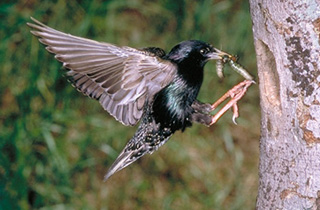European Starling
|
||||
|
Field Marks
Habitat During breeding season, starlings require holes for nesting, as well as open fields for feeding. The usual nesting sites are holes and crevices in trees, buildings, and rooftops. Starlings also plunder other birds' nests and use them as their own. Status European starlings are non-native birds that are displacing native cavity-nesting birds. They are commonly seen in large flocks in suburban and rural areas. They are considered a nuisance because they nest in gutters or vents of buildings, sometimes causing damage. |
|||

